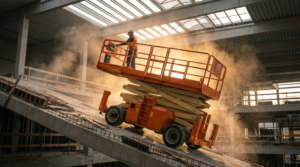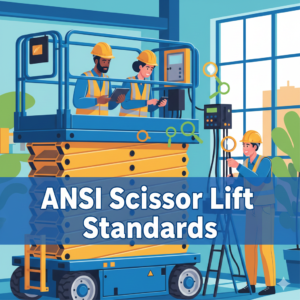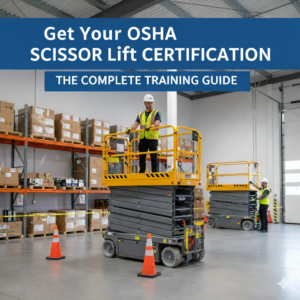Scissor lifts offer a convenient and efficient way to reach elevated workspaces, but safety should always be the top priority. Working at heights comes with inherent risks, and proper training, knowledge, and adherence to safety protocols are crucial to prevent accidents and ensure a safe work environment.
This blog post equips you with essential scissor lift safety tips:
Before Operation:
- Training and Certification: Ensure you have undergone proper training from a qualified instructor and possess the necessary certification to operate the specific scissor lift model you’ll be using.
- Pre-operation Inspection: Conduct a thorough pre-operation inspection before every use. Check for leaks, damage, proper tire pressure, and functionality of all controls and safety features. Refer to the manufacturer’s manual for specific inspection guidelines.
- Work Environment: Assess the work area for overhead hazards like power lines, cables, and other obstructions. Ensure the ground surface is level, firm, and can support the weight of the scissor lift.
During Operation:
- Personal Protective Equipment (PPE): As per the rules, always wear the appropriate PPE, which should include a hard hat, safety glasses, work boots with good traction, and a fall protection system.
- Capacity Limits: Never exceed the weight capacity of the scissor lift platform. This includes the weight of workers, tools, and materials.
- Guardrails: Ensure all guardrails are properly secured and in place. Never climb over, remove, or disable guardrails.
- Movement and Stability: Maintain a smooth and controlled operating speed, especially when moving on uneven terrain. Avoid sudden stops and starts. Use outriggers on uneven surfaces for increased stability.
- Overhead Awareness: Be mindful of overhead obstacles throughout operation. Maintain a safe distance from power lines, cables, and other hazards.
Additional Safety Tips:
- One Person at a Time: Only one person should be on the scissor lift platform at a time, unless the manufacturer specifies otherwise.
- Communication: Maintain clear communication with co-workers and ensure everyone is aware of your movements when operating the scissor lift.
- Weather Conditions: Avoid operating scissor lifts in adverse weather conditions like strong winds, rain, or snow, as they can affect stability.
- Emergency Procedures: Familiarize yourself with the emergency procedures for the specific scissor lift model you’re using, including how to descend safely in case of power failure or other emergencies.
Remember:
Taking safety seriously is paramount when working with scissor lifts. By following these guidelines, undergoing proper training, and prioritizing a risk-free work environment, you can ensure a safe and productive experience working at heights.
Stay tuned for our next blog post, where we explore the different types of scissor lift accessories and their functionalities!





